How Cold Can Marigolds Tolerate? Tips for Gardeners
In your garden, marigolds are a vibrant splash of color that brightens any space. As the temperatures start to drop, you might find yourself wondering how much cold these cheerful flowers can handle.
Marigolds can tolerate temperatures as low as 24-32°F (-4 to 0°C) before frost damage begins to occur. If you’re looking to extend their beauty into the cooler months, it’s crucial to be aware of their cold tolerance.
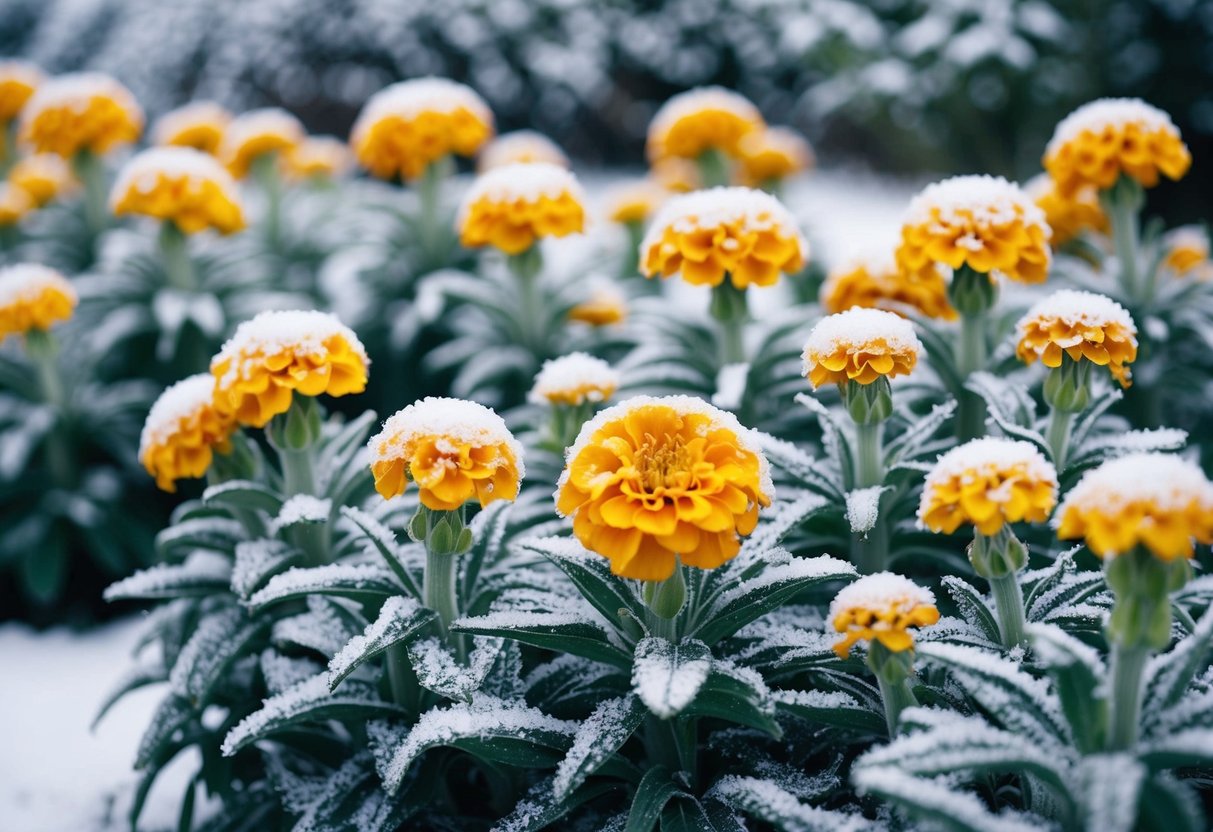
These bright blooms thrive best when the temperature hovers between 35-60°F (2-16°C). During a mild frost, you can take steps to protect them, but remember that marigolds are not frost hardy. Their sensitivity to the cold can limit their ability to thrive during colder weather. Knowing this can help you plan how to keep them around for as long as possible.
By taking a few precautions, you can keep marigolds thriving in your garden even as the chill sets in. With a little care, your marigolds can stay lively and bright despite the cooler climate. Keep reading to discover amazing tips and tricks for maintaining your marigolds through the seasons.
Understanding Marigold Varieties
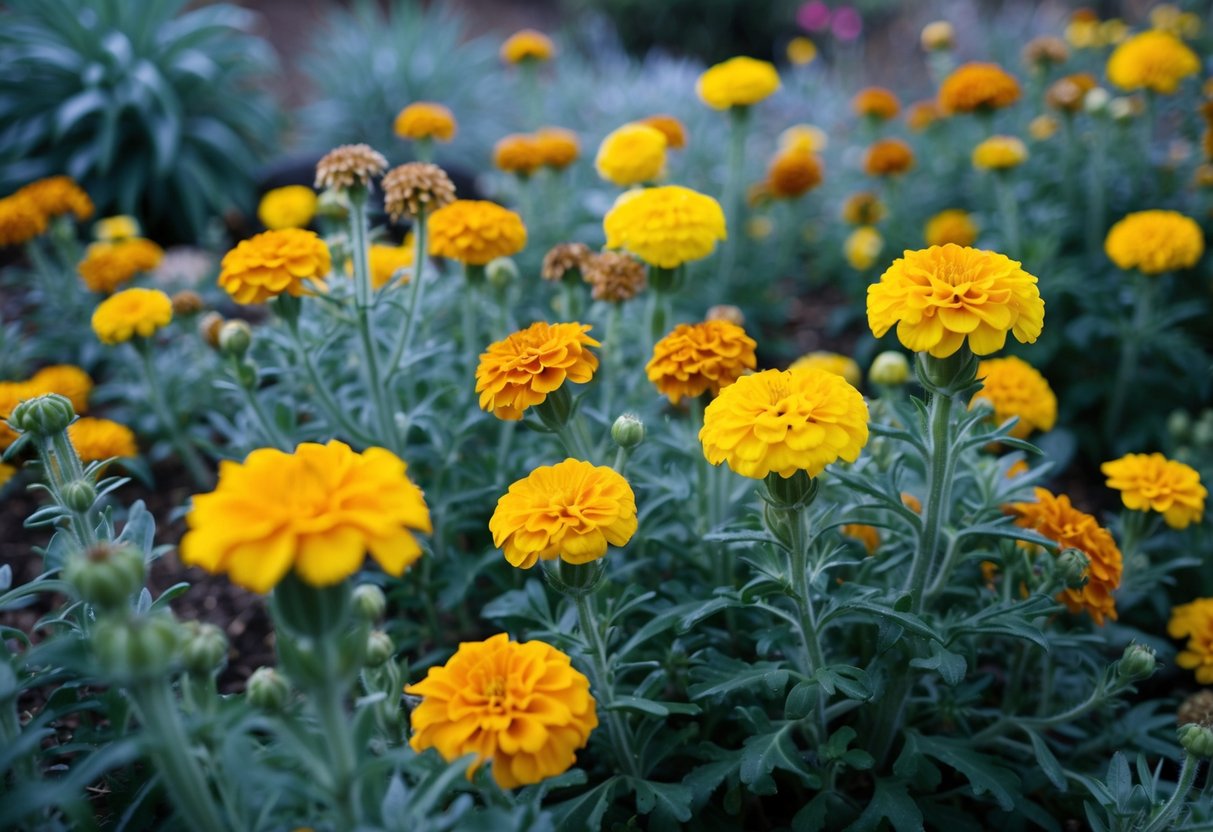
Marigolds come in several varieties with unique features, offering different levels of cold tolerance. Learning about these can help you choose the right type for your garden’s climate.
African vs French Marigolds
African and French marigolds are both popular choices in gardens. African marigolds, known for their large blooms, can withstand temperatures as low as 25°F. They thrive in bright, sunny spots and are great for creating bold visual displays with their vibrant colors.
French marigolds are smaller and more compact but are better at handling cooler temperatures. They can survive down to about 28°F. These annuals are versatile and ideal for use in borders and containers, bringing a splash of color throughout the growing season. Both varieties have a delightful fragrance that repels pests, making them excellent companions in vegetable gardens.
Signet Marigolds and Other Types
Signet marigolds are another charming option known for their dainty, single-petaled flowers. These marigolds are less cold-hardy and prefer warmer environments, making them less ideal for areas with harsh winters. However, their tangy, edible leaves and flowers make them a favorite among culinary gardeners.
Beyond signet marigolds, other types like triploid marigolds are known for being hybrids with sturdy nature and striking color combinations. They are excellent annuals for planting in warmer climates, where they can grow vigorously without the threat of frost. By combining various types of marigolds, you can enjoy a diverse array of colors and textures throughout your garden.
The Impact of Climate on Marigolds

Marigolds thrive in warm weather, but colder temperatures can cause problems. Understanding their preferences helps ensure healthy growth and abundant blooms.
Temperature Preferences
Marigolds love the sun. They thrive best in warm climates where temperatures stay above 70°F (21°C). If you’re growing them in your garden, place them where they can soak up the sun for at least 6-8 hours a day. This is important because marigolds do not handle low light well, which can lead to leggy plants with fewer flowers.
Marigolds can manage mild cold but don’t do well when temperatures drop below 40°F (4°C). If you live in a place with cold nights, you might want to consider using covers to keep them warm.
Dealing With Frost
When the first frost hits, marigolds can suffer. Frost damages leaves and flowers, causing the plants to wilt and die. It’s key to plant marigolds after any threat of frost is over. Usually, this means waiting until the late springtime, around Mother’s Day in some regions.
If unexpected cold weather comes, protect your marigolds with cloth covers or move potted plants indoors. Marigolds are not frost-tolerant, so taking precautions ensures your plants continue to brighten up the garden. If temperatures often dip to freezing in your area, consider alternatives like hardier plants.
Cultivating Marigolds Successfully
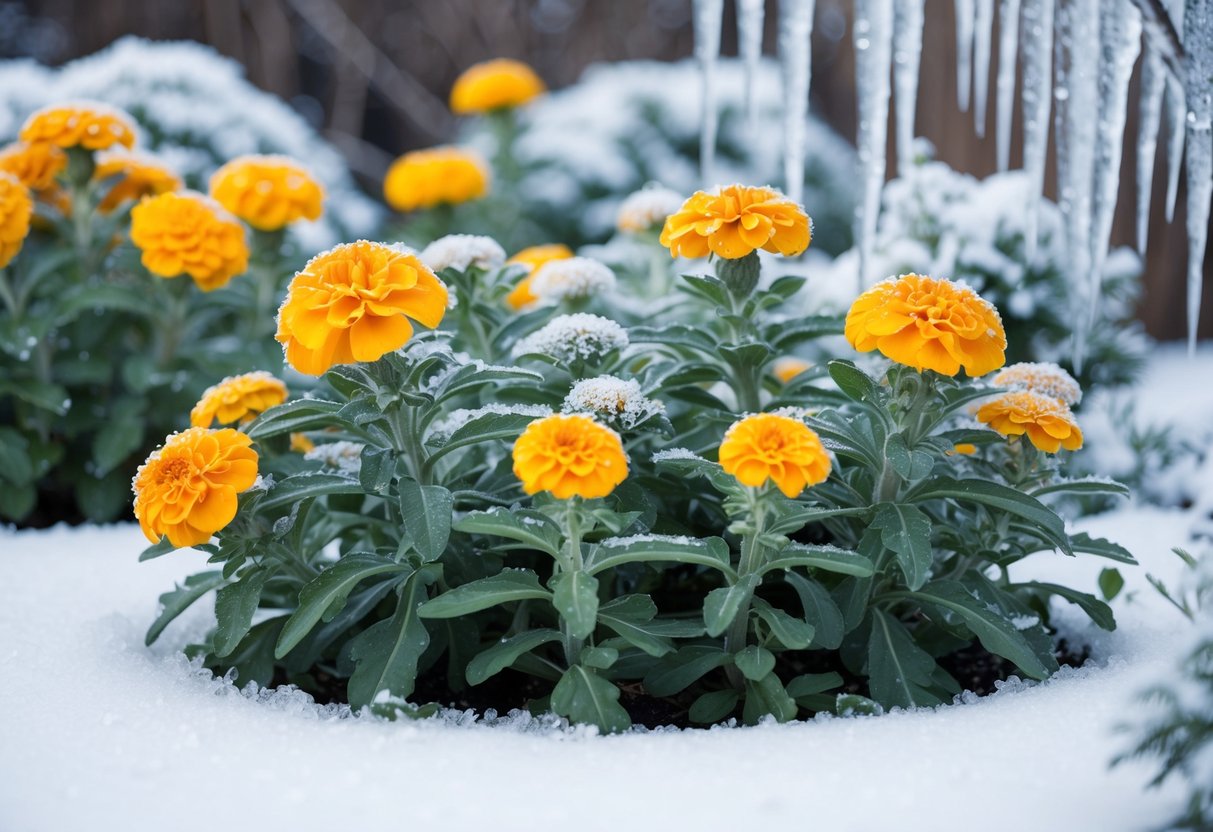
To grow marigolds effectively, it’s important to focus on their soil and sunlight needs, provide proper watering and nutrition, and ensure protection from extreme conditions. Understanding these factors will help your marigolds flourish.
Soil and Sunlight Needs
Marigolds thrive in full sun and require well-draining soil. These flowers do best in soil with a neutral pH, around 6.0 to 7.0, and prefer a leaner soil rather than one rich in organic matter. Adding a bit of compost can enhance soil quality. Aim for eight hours of direct sunlight daily, as shade can affect their growth.
Make sure the soil is neither too acidic nor too heavy with clay, as this can impede growth. Soil temperature also plays a role. Wait for warmer conditions before planting. Ensure good air circulation by spacing plants appropriately to promote healthy growth.
Watering and Nutrition
Marigolds are drought tolerant but still need regular watering. Water them in the morning to ensure the soil remains moist, but avoid overwatering, as soggy soil can lead to root rot. Use mulch to help with moisture retention. This practice also keeps the soil temperature stable.
A balanced fertilizer can be applied every month for nutrient support. Avoid excessive nitrogen as it leads to leafy growth but fewer blooms. Keep an eye on yellowing leaves; it might mean your marigolds need more nutrients.
Protection and Maintenance
Protection is key to healthy marigolds. These flowers do not tolerate frost, so plant them after the last frost date in your area. If frost is expected, cover them with cloth or bring pots inside. Regular mulching helps protect the roots and maintain soil temperature.
Deadheading, or removing spent flowers, encourages new growth and blooms. This maintenance step is simple but important for prolonging the blooming period. Keep your garden looking vibrant by snipping faded blooms regularly. Additionally, check for pests and treat any infestations early to prevent damage to your marigolds.
Growing Marigolds Through the Seasons
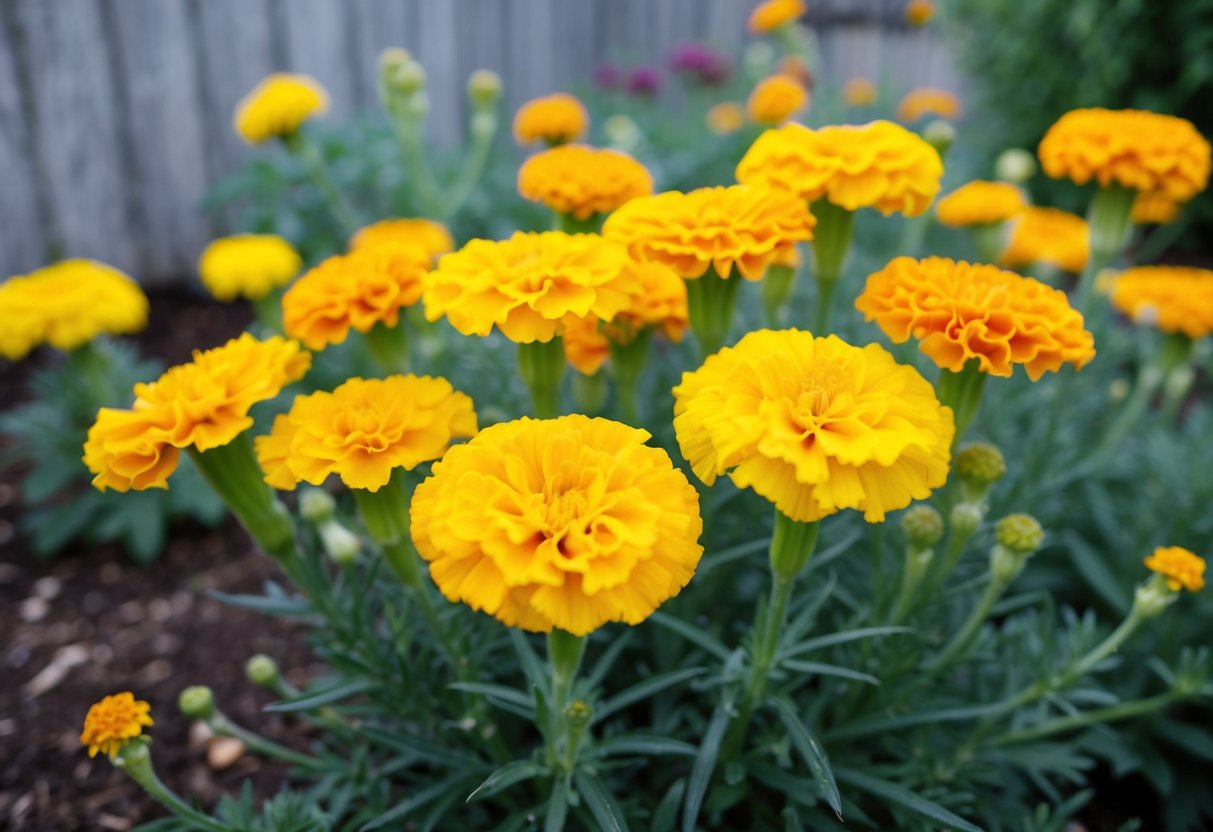
Marigolds are vibrant flowers that can brighten up your garden throughout the year. Mindful planting and care during different seasons help them thrive. Here’s how you can keep your marigolds growing strong.
Spring Planting Tips
In spring, it’s time to start planting marigolds. Begin with marigold seeds or young plants after the danger of frost has passed. Choose a sunny spot in your garden or use raised beds if the ground is still chilly. Proper sunlight helps marigolds burst into bloom.
Ensure the soil is well-draining. Marigolds prefer soil that is not too rich in organic matter, so amend the garden bed with a lean mix. Space the French and signet marigolds 8 to 10 inches apart. Larger varieties, like African marigolds, need more room. Water them thoroughly after planting to encourage deep root growth.
Tip: Regularly check for any weeds around your young plants. Weeds can compete for nutrients needed by your marigolds and may stunt their growth.
Preparing for Fall and Winter
As temperatures start to drop, there are easy steps you can take. In fall, continue to water your marigolds regularly, but not as much as in summer. Consider using mulch around the base of the plants to help retain warmth in the soil. Raised beds can also offer extra protection against early frost.
When winter is approaching, you can keep marigolds inside in pots if your climate sees cold seasons with frost. If you leave them outdoors, snip off any dead blooms and cover the plants with frost blankets. Move pot-grown marigolds to a sheltered spot like a porch.
Remember to water them deeply but less frequently during colder months to prevent frost damage.
Leveraging Marigolds in Garden Design
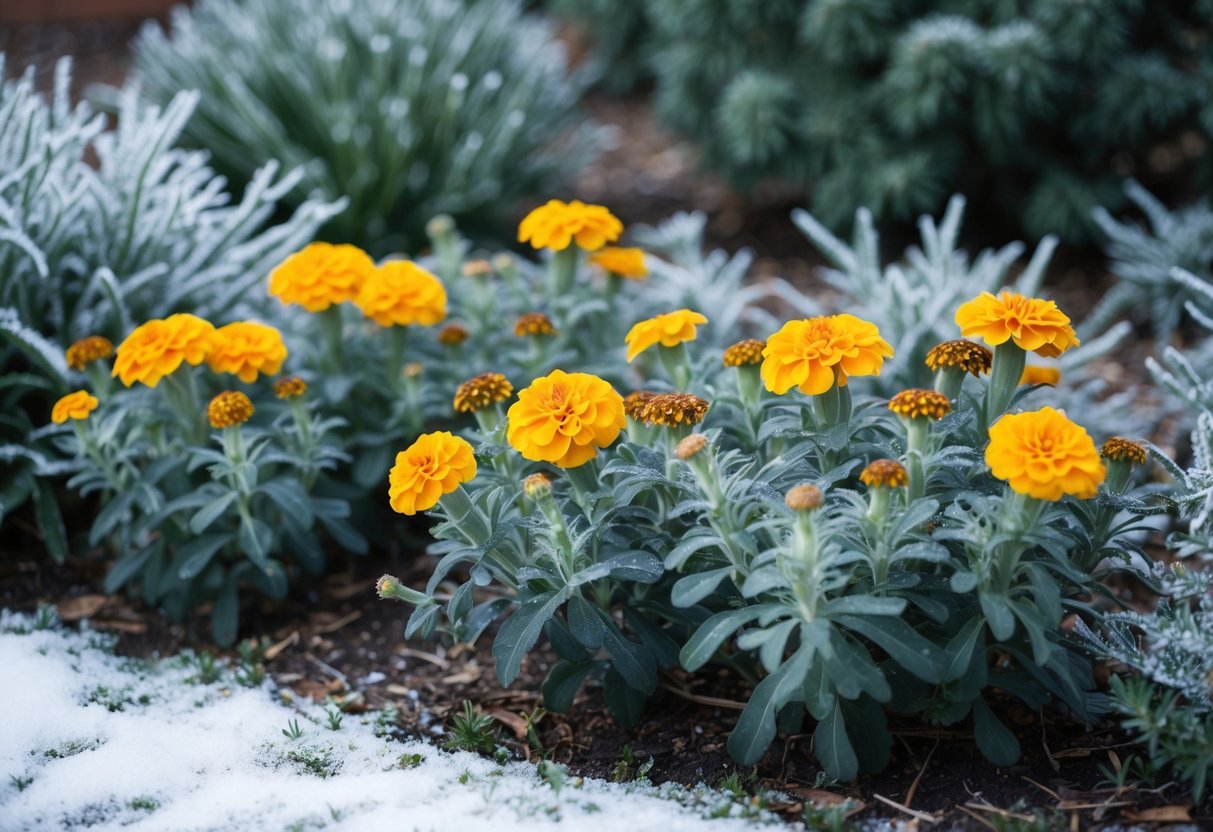
Marigolds can be more than just bright flowers in your garden. They can serve important roles, from beneficial companion plants to adding lively aesthetics.
Companion Planting
Marigolds are often chosen for companion planting due to their ability to deter pests. Planting marigolds next to vegetables like tomatoes can help keep harmful insects away. Their presence attracts beneficial pollinators, enhancing overall garden health.
They are also simple to grow from seedlings, making them a practical choice for both new and experienced gardeners. Marigolds require low maintenance, allowing you to focus more on cultivating other plants in your garden. They can thrive in various conditions, with seeds showing promising germination rates.
Aesthetic Contributions and Uses
Marigolds contribute vibrant colors that can brighten up different garden areas. Whether used in garden beds or patio containers, they provide a splash of color that is hard to miss.
Marigolds are also valued for their potential as edible flowers. They can be used to add color and a unique flavor to salads and dishes. Their versatility makes them an appealing choice for those looking to enhance garden design with beauty and practicality.







